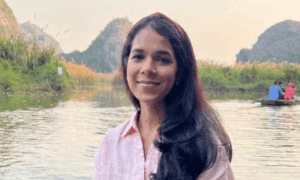Machine learning expert Abylaikhan Azamatov shows how local solutions create global impact through adaptive AI implementation
In today’s rapidly evolving technological landscape, artificial intelligence is transforming the banking sector, offering significant advantages while presenting complex challenges. According to a recent article in The Wall Street Journal, over the past year, JPMorgan Chase Bank has implemented a tool called LLM Suite for most of its employees, allowing 300,000 people to use generative AI in their work. About half of them actively use it daily, spending an average of one to two hours per week working with this tool. Experts who understand the nuances of implementing AI systems across different contexts and infrastructures are increasingly rare and valuable in this environment. Abylaikhan Azamatov represents this new breed of AI professionals. With successful projects implemented across multiple regions and technical environments, the 25-year-old engineer has demonstrated a remarkable ability to adapt complex machine learning solutions to vastly different requirements – from parking automation systems to financial anti-fraud measures and language models.
How does implementing AI in traditional banking differ from your previous work with cryptocurrency platforms?
Traditional banking requires a fundamentally different approach than what I experienced at Latoken. Banks operate with monolithic architectures and strict regulatory frameworks that significantly impact development cycles. Every AI implementation must go through extensive verification processes. At Latoken, we used a flexible microservice architecture with rapid updates and agile development cycles. The technical architecture creates entirely different constraints – from data access patterns to deployment timelines. This contrast taught me to adapt AI solutions to very different organizational structures and technology stacks.
Your career moved from backend development to specialized AI applications. What sparked this transition?
My journey began after graduating with a gold medal from school and completing my Information Technology degree. Working as a Backend Python Developer in Moscow gave me my first exposure to integrating ML models into server systems. I discovered that AI could solve tangible business problems with measurable impact. This realization led me to specialize first in financial applications at Bank Center Credit, then expand into computer vision and broader AI implementations. The technical progression from server-side programming to specialized machine learning allowed me to build systems with increasingly sophisticated capabilities.
At Kazakhstan top bank you developed an anti-fraud system that reduced fraud by 25%. How did you achieve this result?
The system analyzed transactions in real-time and identified suspicious patterns with high accuracy. The key innovation was developing models specifically calibrated for legal entities’ transaction behaviors rather than using generic fraud detection approaches. The technical challenge was balancing computational efficiency with detection accuracy – we needed to process enormous transaction volumes without introducing latency. This project demonstrated that properly implemented AI can deliver significant financial impact through risk reduction.
Your experience spans environments with different technological infrastructures. How did implementation approaches adapt to these varied technical constraints?
In environments with exceptional infrastructure, we could focus on perfecting solutions rather than overcoming limitations. Projects in these settings emphasized thorough testing and documentation, with high standards for model accuracy. In contrast, when facing connectivity and hardware constraints, we had to deploy local servers and optimize models for less powerful hardware. These technical limitations actually drove innovation—we developed efficient models that delivered strong performance with minimal resources, something that proved valuable even in better-equipped environments.
Speaking of adapting to different environments, your work at Parqour involved implementing AI in physical infrastructure. How did you approach this parking automation challenge?
We used YOLO for license plate detection and developed our own CNN for recognition, increasing vehicle recognition speed by 30%. Our focus on autonomous operation made wide deployment possible. Each installation could function with intermittent connectivity, storing data locally and synchronizing when connections were available. We also designed the system to work under challenging weather conditions – Kazakhstan experiences extreme with temperature variations that affect camera performance. From a technical perspective, the key innovation was optimizing the inference pipeline to perform accurately on modest hardware while maintaining robustness to environmental variations. The system’s success led to government interest from municipal authorities, and I presented the technology for potential smart city applications.
Beyond technical work, you’ve shown entrepreneurial initiative with multiple businesses – an app development studio, a lounge bar, and gaming clubs – and even founded a CS:GO team. How has this diverse business experience shaped your approach to technology?
My entrepreneurial ventures gave me a multifaceted perspective that profoundly influenced my technical work. Running a lounge bar and two PlayStation gaming clubs—where we increased the customer base by 30% in the first year – taught me that end-users don’t care about technical elegance if the solution doesn’t solve their problem efficiently. Being among Kazakhstan’s top FIFA players and founding a competitive CS:GO team developed my abilities in split-second decision-making, team coordination under pressure, and strategic adaptation. Meanwhile, the app development studio, where we delivered five successful projects, showed me how to balance technical possibilities with business requirements. I now approach AI projects with all these perspectives combined—prioritizing solutions that deliver tangible business value while maintaining technical excellence and building resilient teams capable of performing under constraints, just like in competitive gaming environments.
What specific differences have you observed in how countries approach AI implementation across different projects?
Each technical environment has its distinct approach that reflects its organizational priorities. Some teams take a methodical approach with deep preliminary research and multi-level testing, emphasizing precision and documentation. Others focus on rapid deployment with quick scaling, often integrating government resources and registries. Some organizations implement AI gradually, with strong regulatory influence and data security requirements. Others adopt AI incrementally, requiring economic justification for each project and favoring simpler models with lower computational demands. These differences in technical culture significantly impact how AI solutions need to be architected and deployed.
Finally, what advice would you give to young professionals looking to build successful careers in AI?
Build practical projects that solve real problems, even small ones, rather than just studying theory. Develop technical and communication skills—explaining complex concepts to non-technical stakeholders is crucial for successful implementation. Think globally but apply locally, understanding international best practices while adapting them to specific regional challenges. Most importantly, don’t be afraid to take risks and learn from failures—they’re essential steps toward innovation and growth in any market.





























